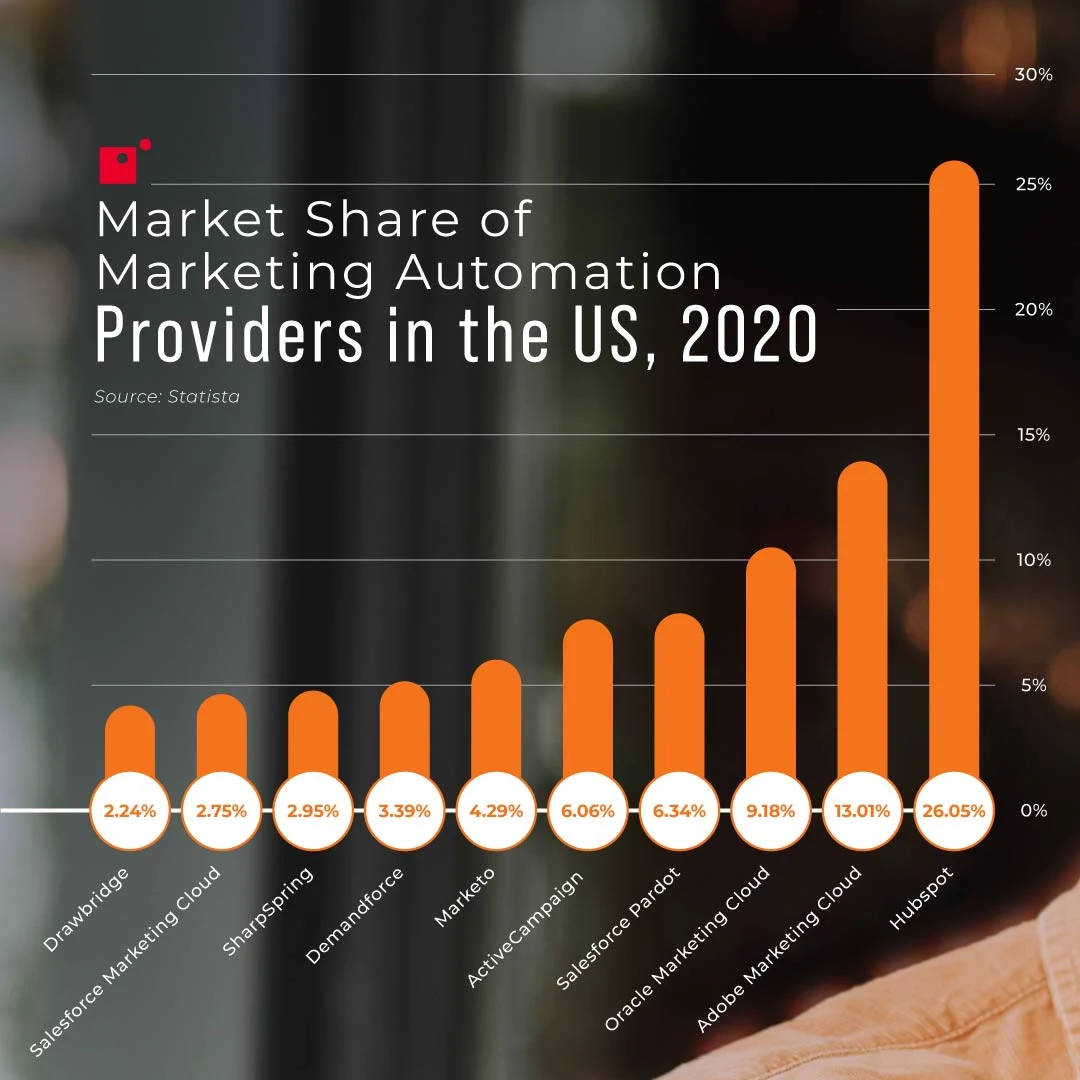
Image source: Freepik.com
Marketing Technology or MarTech is a fancy term we throw around a lot these days.
Google says people in the U.S. search for it like 10,000 times a month. But here’s the thing – when discussing MarTech or Marketing Technology, it’s not just one thing. Some folks might call it a buzzword, but the reality is, that this techy marketing stuff is becoming super common, especially in digital marketing agencies.
So, let’s break it down: What does MarTech mean, why does it matter, and what problems are marketers dealing with right now? This is what we’ll cover in this definitive guide to marketing technology.
What Is Marketing Technology (MarTech)?
Marketing Technology or Martech is like the secret sauce for digital marketers. It’s this cool combo of marketing tricks and techie tools that helps them create, spread the word, automate stuff, and tweak their marketing game.
Picture this: from flashy ads and promos on online shops to the stuff you see on web pages, and even the content you come across on your journey to buying something – martech is the wizard behind the scenes. It gives marketers the lowdown and the power to make smart choices based on data. That means better marketing campaigns and the ability to tailor things for customers.
And it’s not just about bombarding them with messages; it’s about being smart and reaching out through different channels.
Take email, for example. Martech makes it a breeze for marketers to shoot out emails triggered by what you do. Like, imagine you visit a website, drop your email to grab some cool info, and bam!
Thanks to Martech, you might get an email inviting you to a webinar or serving up more personalized info about what they’re selling. It’s like marketing magic that also helps marketers get the lowdown on what you dig, just by keeping tabs on what you click in their emails.
A Brief On AI’s Role In Marketing Technology

Image source: Freepik.com
Artificial intelligence (AI) is becoming a big part of martech, right? It’s getting mixed in to give us better insights, do tasks on its own, and make things run smoother.
Think about it – AI tools can crunch a ton of data way faster and more accurately than we humans. In marketing, where knowing your customers is everything, this can be a game-changer for campaigns. And get this, generative AI can even help marketers come up with cool stuff like email subject lines, social media posts, and blog articles.
But here’s the deal – using AI in martech needs a game plan. It’s a powerful tool, sure, but you gotta know what it can and can’t do. Team up with human know-how and use AI strategically – that’s the secret sauce.
How Important Is MarTech?
Martech tools do the heavy lifting in digital marketing. They handle everything from creating and testing content to putting it out there and keeping an eye on how it’s doing.
These tools help you track the entire customer journey, determine where you might be losing potential customers, and spot any issues in your marketing strategy that might be costing you sales.
And the best part?
They let you tweak things to get more people engaged and boost your conversion rates.
In a nutshell, martech tools make your marketing life easier and faster.
You can do more with less effort, thanks to these tools. But, as the number of martech tools goes up, you’ll need to manage and integrate them properly. marketing technology just has innumerable benefits for marketers.
We’ll dive into the details of that in the next part of this guide.
5 Benefits of Leveraging Marketing Technology
Now, let’s delve into the advantages that come with leveraging martech, combining both the conversational and professional aspects. This includes a boost in operational speed, the automation of routine tasks, and the integration of more robust tools to yield superior outcomes.
1. Let’s kick off with the generation of superior and well-qualified leads. Lead generation stands as a pivotal initial phase in any successful marketing campaign. Employ martech tools that support digital ads, email marketing, search engine marketing, and more to craft effective lead-generation strategies. These tools serve to expand the marketer’s reach, attracting a broader audience and engaging potential customers more effectively.
2. Next up, is the multichannel perspective on prospect behavior. Martech platforms excel at consolidating data from various channels, presenting a holistic view of a prospect’s behavior. This invaluable insight empowers marketers to comprehend their audience more deeply, allowing for the customization of marketing strategies to align seamlessly with audience preferences.
3. Moving on, there’s an improvement in conversion rates and a superior return on investment (ROI). Martech encompasses tools facilitating A/B testing, incrementality testing, remarketing, upselling, and other initiatives to boost conversions and optimize ROI.
4. Let’s not forget the game-changing aspect of task automation. One of the key perks of martech is its ability to automate mundane and repetitive tasks, whether it’s scheduling social media posts or orchestrating email campaigns. This automation liberates marketers, allowing them to redirect their time and energy toward more strategic and creative endeavors.
5. Lastly, we can’t overlook the competitive advantage bestowed by advanced martech tools. Businesses utilizing these tools gain a competitive edge by delivering enhanced customer experiences, expanding their audience reach, and fine-tuning their marketing strategies based on data-driven insights.
MarTech vs AdTech: How Do They Differ?
So, you’ve got these tech tools in the marketing and advertising world, and sometimes telling them apart can be a bit tricky.
Here’s a quick rundown:
Firstly, there’s AdTech – short for advertising technology. It revolves around tools for targeting, buying/selling, displaying, and tracking digital ads. Companies turn to AdTech to manage, measure, and optimize their ads for snagging those new customers.
The key players in AdTech include:
- Data management platforms (DMPs)
- Demand-side platforms (DSPs)
- Supply-side platforms (SSPs)
- Ad exchanges
On the other side of the coin, there’s MarTech – short for marketing technology. This is all about the tools that help you communicate smoothly with both potential and existing customers through websites, emails, social media, mobile, and other channels. Some experts may argue that AdTech is a subset of MarTech.
The big names in marketing technology include:
- Customer relationship management (CRM) platforms
- Customer data platforms
- Marketing automation platforms
- Social media management platforms
- Personalization platforms
- Content creation and optimization platforms
- Analytics and testing platforms
So, that’s the rundown – advertisement technology for flashy digital ads, and marketing technology for seamless communication with your customers.
What Is Martech Stack?
A MarTech stack essentially constitutes a lineup of various marketing technology systems collaborating seamlessly to enhance your marketing endeavors. It’s like weaving an interconnected web of tools tailored to meet the specific goals of your business or brand. This customization is vital for adapting processes according to your customers’ distinct behaviors, ultimately maximizing your return on investment.
A comprehensive MarTech stack empowers you to not only attract and engage customers but also gain insights and drive conversions. It functions as a holistic approach, ensuring that you connect with the right audience at every stage of the purchase funnel.
In most stacks, there’s a cornerstone component known as a digital asset management (DAM) solution. This DAM solution is essentially the beating heart of any MarTech stack, offering a centralized hub for content and asset management. Its role in maintaining consistency across different touchpoints cannot be overstated. As you embark on building your stack, this becomes a pivotal consideration.
However, constructing the stack is just the beginning; managing these marketing technology tools is an ongoing necessity. Keeping them in harmony is integral to your marketing strategy’s success.
So, before diving into the intricacies, let’s take a step back and walk through the process of actually building your MarTech stack.
A Brief On Building A Martech Stack
Crafting a MarTech stack kicks off with addressing a pivotal query: What are your objectives and key results (OKRs)? Your response sparks the journey, but let’s delve into the comprehensive list of crucial steps.
1. Marketing metrics
Begin by pinpointing the sought-after outcome we highlighted earlier. This might hinge on your business model, brand type, sales cycle length, and more. Establishing goals or key performance indicators (KPIs) provides a roadmap to success.
2. Unique value proposition
As you shape that goal, contemplate your brand’s unique value. What sets you apart? What distinguishes your company in your industry? Grasping these differentiators aids in identifying fitting MarTech tools and resources.
3. Capabilities
Before plunging into new possibilities—though enticing—it’s vital to assess your arsenal of existing tools. Are there systems underutilized? Can some be employed differently? Keeping this in mind ensures you’re not redundantly tapping into opportunities already available for your business.
4. Customer Journey
Construct your marketing stack based on your customers’ distinctive journey through the marketing funnel. Predictably, understanding these touchpoints is essential before influencing them.
So, you’ve tackled these pivotal questions and scrutinized these facets of your business.
What comes next?
It’s now time to concretely begin assembling the pieces into your marketing technology stack.
How Profitable Is A Job In Marketing Technology?

(source: martech.org)
In Marketing Technology, the paycheck game is strong, as revealed by the 2022 MarTech Salary and Career Survey. The study points out that folks tagging themselves as part of this tech-savvy marketing crew are raking in some serious cash.
In the salary spotlight, the survey unveils that the average earnings for marketing pros clocked in at almost $138,000 in 2023. Surprisingly, this figure mirrors the numbers from the 2022 edition of the survey, holding steady.
Now, let’s talk hierarchies.
Those steering the marketing ship at the top, like senior management and directors, are pulling in a cool double compared to the hardworking staff. In the managerial arena, marketing managers are leading the pack, scoring around 20% more than their staff counterparts.
Current Martech Trends To Look For
Data Consolidation: Ensuring all customer data is streamlined, cleaned, and ready for analysis is crucial in today’s landscape. Employing a Customer Data Platform (CDP) is now widely acknowledged as the most effective way to achieve this.
Marketing Data Leadership: Recognizing the pivotal role of customer data in successful marketing, organizations are increasingly appointing a dedicated Director of Marketing Data. This role focuses on the efficient collection, integration, and utilization of customer data while prioritizing security and privacy. Alternative titles include Marketing Data Architect and Marketing Data Manager.
AI and Automation Surge: The marketing technology space is experiencing a surge in tools utilizing artificial intelligence (AI) for data analysis, generating insights, predicting customer behavior, and automating various large-scale tasks. AI empowers marketers by handling time-intensive activities, allowing them to concentrate on the creative and strategic aspects of their work.
Personalized Real-time Engagement: The convergence of real-time customer data integration and AI-driven automation enables marketers to deliver highly personalized messages and incentives to individual customers promptly. This approach caters to customer actions, preferences, and scenarios, addressing issues immediately and providing desirable real-time messaging at scale, representing the future of automated B2C marketing.
Data Privacy Focus: Marketers and martech vendors are now more attuned to data privacy and regulations than ever. With GDPR, CCPA, HIPAA, EU-US, and Swiss-US Privacy Shield Frameworks, and other consumer privacy laws, coupled with increased media attention on data privacy incidents, the landscape has evolved. Stricter regulations, higher fines, and increased consumer awareness compel marketers to closely scrutinize their data-related tactics and tools.
Success Of Marketing Technology & Data Backing It Up

(source: Statista)
The widespread integration of big data in various industries has presented a range of challenges, such as addressing cybersecurity concerns and mastering the art of organizing and presenting copious amounts of data.
However, within these challenges lies a significant opportunity, especially for those equipped with the right technology.
The abundance of data translates into a wealth of information about both existing customers and potential leads, offering valuable insights to shape strategies and enhance overall decision-making. Yet, the key lies in leveraging technology solutions capable of effortlessly handling tasks like storage, organization, structuring, and reporting, sparing humans from overwhelming manual processes.
Enter AI and machine learning tools, such as CRM, which empower businesses to aggregate, analyze, and operationalize the massive volumes of data at their disposal.
Moreover, contemporary Marketing Technology (MarTech) solutions are designed to seamlessly integrate with systems across various departments. This not only aids in unifying data but also enables marketers to access information that was previously out of reach, thereby elevating overall business productivity.
What Does The Future Hold For Martech?
The landscape of marketing technology is poised for continuous evolution, driven by advancements in technology, heightened data privacy regulations, and shifts in customer purchasing behavior and expectations. Here are some key areas to keep an eye on:
1. Contextual Targeting vs. Behavioral Targeting: The shift from behavioral to contextual targeting is gaining momentum. Behavioral targeting relies on data from visitors’ browsing habits, tailoring ads based on search terms, visited sites, and purchases. However, as privacy regulations like GDPR and CCPA tighten control over visitor data, contextual targeting, which focuses on displaying relevant ads based on website content rather than individual data, is on the rise.
2. Customer Data Platforms (CDP): Marketing technology is witnessing the growth of Customer Data Platforms (CDPs), aiming to consolidate all customer data for unified profiles accessible to various systems. While finding an all-encompassing CDP is challenging, industry leaders like Salesforce, Oracle, and Adobe are enhancing their CDP platforms by integrating AI and machine learning, broadening their functionalities.
3. Immersive and Experiential Marketing: Anticipate the evolution and expansion of immersive and experiential marketing tactics. Innovations in this realm will likely include more immersive virtual experiences utilizing 3D augmented reality, virtual reality technology, and novel approaches to leveraging 5G mobile networks for enhanced virtual connectivity.
4. AI-Powered Automation and Personalization: The role of AI in automating and personalizing marketing efforts is becoming increasingly pivotal. AI-driven algorithms can analyze vast datasets, discern patterns, and provide data-driven recommendations. This empowers marketers to automate routine tasks, optimize campaigns, and deliver personalized experiences to customers. AI-driven tools are instrumental in content generation, customer segmentation, predictive analytics, chatbots for customer support, and recommendation engines for personalized product suggestions. In essence, marketing technology relies on AI to enhance efficiency and tailor experiences for maximum impact.
Summing Up
In this comprehensive exploration of Marketing Technology (MarTech), we’ve dissected its significance, delved into the role of Artificial Intelligence (AI), uncovered the benefits of leveraging MarTech tools, distinguished MarTech from AdTech, explored the concept of MarTech stack, and even discussed the lucrative landscape of jobs in this tech-savvy marketing domain.
As we navigate through the evolving trends and prospects of MarTech, it becomes clear that this fusion of marketing strategies and technological tools is not just a buzzword but a transformative force in the digital marketing realm.
Key Takeaways:
- Marketing Technology (MarTech) blends marketing strategies with technological tools for digital marketing success.
- AI plays a crucial role in data analysis, content generation, and strategic decision-making within MarTech.
- MarTech tools streamline lead generation, analyze prospect behavior, automate tasks, and provide a competitive edge.
- Building a customized MarTech stack is essential for businesses aiming to maximize their return on investment.
- Jobs in Marketing Technology are not only lucrative but also showcase stability, with professionals earning an average of nearly $138,000 in 2023.
People Also Read:
Popular Martech Groups On LinkedIn.
MarTech companies are Raking In The Money
Marketing Services That Lose Efficacy When Insourced
Unlock Your Full Marketing Potential with a Customer Data Platform
Why Customer Data Platforms are important for creating unified customer profiles?




